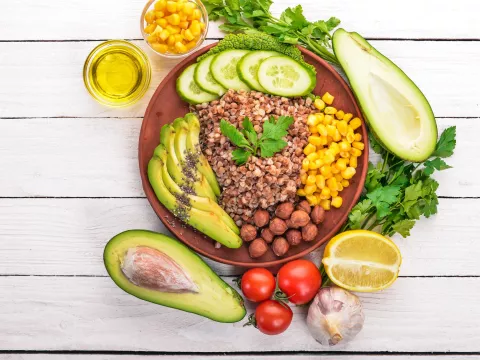- AdventHealth

We hear about the benefits of including whole foods, plant-based foods, lean protein and ‘good carbs’ into our daily meals, but it may not be the easiest thing to do. When trying to build a better plate of food, sorting through all the options requires patience, persistence and a few helpful tips.
As you build your healthy plate that promotes whole health and wellness, keep in mind the five essential food groups that help lay the foundation for a healthy meal —fruits, vegetables, proteins, grains and dairy.
A Healthy Plate of Food Can Boost Energy, Improve Health and Increase Productivity
A colorful plate of food looks a little bit like a rainbow. And all those colorful foods can lead to maximum nutrition. With a bit of planning, the courage to try new foods and balancing healthy fats, lean protein, vegetables and healthy sweets even the novice cook can create a food plate that fuels your body, mind and spirit.
Make a Plan
Planning out your meals can help keep your healthy eating ambitions on track. Because most of us are super busy and on the go, planning helps you avoid the temptation of grabbing what may be convenient food that’s highly processed and lacks nutritional value. When you make a plan, it also helps you save time and money, reduce waste and decrease stress.
Look for Seasonal Options
Grocery stores offer most of our favorite fruits and vegetables year-round. Eating with the season though has many health benefits, and it’s environmentally sustainable. When you build your plate, look for foods recently harvested and try to avoid fruits and vegetables that have been shipped across the country or from around the world.
Eat Nutrient-Dense Foods
Getting enough nutrients in your diet is important. That means choosing foods with healthy substances such as vitamins, minerals, whole grains and fiber. Nutrient-dense foods offer fewer calories but fill you up faster. Try these:
- Fruits including blueberries and blackberries
- Green leafy vegetables such as spinach and broccoli
- Nuts, seeds
- Oily fish rich in omega-3 fatty acids, such as salmon
- Whole grains such as quinoa
Choose a Rainbow of Colorful Food
It’s true. The more colorful the food, the more nutrients you’re taking in. Choose some of our favorite colorful, healthy foods:
- Blue — blueberries, blackberries, eggplant
- Green — broccoli, kale, spinach
- Orange — carrots, sweet potatoes, apricots
- Red— strawberries, raspberries, tomatoes, red peppers
- White — cauliflower, onions, garlic
Divide Your Plate into Sections
Remember that proportions do matter. Most people eat their food on a nine-inch plate. If you need help balancing your nutrients, try dividing your plate into sections. Half of your plate should be non-starchy vegetables; a quarter of your plate should be lean protein and the other quarter should be whole grains.
Don’t Be Afraid to Try New Foods
Sometimes the strong flavors, aromas and texture can make a child cringe. As adults, most of us have outgrown selective taste buds. If you’re still struggling to incorporate new foods try these tips:
- Ask a friend to try the new food with you
- Be patient with yourself
- Involve the family to learn about a new culture and share a meal
- Start with a small portion
- Take a couple of bites before you decide you don’t like the food
Include Family and Friends When Cooking
Sharing a meal with others can help build healthy habits. Planning and cooking together also helps when it comes to building a nutritious meal. Friends and family can motivate each other and offer encouragement too.
Limit Unhealthy Fats
When building a healthy plate watch out for hidden fats especially foods containing saturated and trans fats like fried foods, hydrogenated oil, butter and fatty meats. Most people don’t realize that sweet foods like cakes and cookies have more fat than sugar. Try to cut down on those types of sugary foods.
Choose Healthy Sweets to Satisfy that Sweet Tooth
There are guilt-free and healthy ways to enjoy a sweet treat. When your sweet tooth kicks in, try some of the following options:
- Cottage cheese with fruit
- Dark chocolate covered almonds
- Fresh fruit including frozen grapes
- Sorbet
- Yogurt parfait
Include Lean Protein
Protein comes from both animal and plant sources. Remember to add variety in lean protein choices throughout the week. Doing so can help prevent boredom in food choices. Lean animal protein includes options like eggs, poultry and lean meats. Plant-based protein includes kale, beans and nuts.
Remember to be patient with yourself. It’s okay if you veer off your nutritional path for a day, try to make up for it the following day. Making gradual nutritional changes can help ensure the changes you make are for life and not just temporarily.
Healthy nutrition is just one step to feeling whole. If you're trying to lose weight, we can guide you the rest of the way. Find out how.




